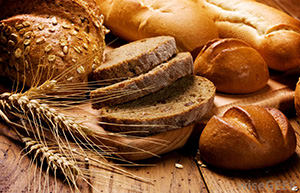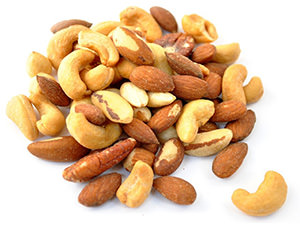
Different Types Of Fibre And Their Health Benefits
Posted on 13 Sep, 2020

We are always being told to eat fibre to keep regular, but it has many other health benefits. It can help those with diabetes by balancing blood sugar levels, help strengthen the digestive and immune system, and through its cholesterol-lowering abilities, help curb heart disease.
To get all these benefits, there are two types of fibre that your body needs: soluble and insoluble. Both come from plants and are forms of carbohydrates. But unlike other carbs, fibre can’t be broken down and absorbed by your digestive system. Instead, as it moves through your body it slows digestion and makes your stools softer and easier to pass.
 Most foods contain both insoluble and soluble fibre but are usually richer in one type than the other. The easiest way to tell them apart: Soluble fibre absorbs water, turning into a gel-like mush (think of what happens when you add water to oatmeal) while insoluble fibre doesn’t (think of what happens when you add water to celery).
Most foods contain both insoluble and soluble fibre but are usually richer in one type than the other. The easiest way to tell them apart: Soluble fibre absorbs water, turning into a gel-like mush (think of what happens when you add water to oatmeal) while insoluble fibre doesn’t (think of what happens when you add water to celery).
Soluble Fibre
 Soluble fibre is found in legumes, oats, brown rice, fruit, beans, vegetables and seeds. Or try sprinkling a tablespoon of psyllium husks over cereal or add to smoothies, juice or yoghurt. These fibres help lower LDL (bad) cholesterol and help regulate blood sugar levels for people with diabetes.
Soluble fibre is found in legumes, oats, brown rice, fruit, beans, vegetables and seeds. Or try sprinkling a tablespoon of psyllium husks over cereal or add to smoothies, juice or yoghurt. These fibres help lower LDL (bad) cholesterol and help regulate blood sugar levels for people with diabetes.
The health benefits include:
Heart Protection
Soluble fibre also helps lower cholesterol, reducing the risk of heart disease. Inside your digestive system, soluble fibre attaches to cholesterol particles and takes them out of the body, helping to reduce overall cholesterol levels and the risk of heart disease. Oatmeal may offer the most heart protection.
Diabetes Control
Soluble fibre helps maintain healthy blood sugar levels, which helps with prevention and treatment of type 2 diabetes. They bind with fatty acids and slow digestion so blood sugars are released more slowly into the body.. If you already have diabetes (either type 1 or type 2) soluble fibre can even help prevent sugar blood sugar spikes and keep your condition under control.
Weight Loss
Soluble fibre can also help you get to -- or stay at -- a healthy weight by keeping you feeling full without adding many calories to your diet.
Healthy Bowel Movements
Soluble fibre soaks up water as it passes through your system, which helps bulk up your stool and guard against constipation and diarrhea. In fact, most fibre supplements contain mostly soluble fibre.
Strengthens Immune System
Soluble fibre helps strengthen the immune system by stimulating the growth of beneficial intestinal bacteria.
Types Of Soluble Fibre
Inulin Oligofructose
Sources: Extracted from onions and by-products of sugar production from beets or chicory root. Added to processed foods to increase fibre.
Benefits: May increase beneficial bacteria in the gut and enhance immune function.
Mucilage, Beta-glucans
Sources: Naturally found in oats, oat bran, beans, peas, barley, flaxseed, berries, soybeans, bananas, oranges, apples, carrots.
Benefits: Helps lower bad LDL cholesterol, reduces risk of coronary heart disease and type 2 diabetes. Use caution if celiacor gluten intolerant.
 Pectin and Gums
Pectin and Gums
Sources: Soluble (some pectins can be insoluble). Naturally found in fruits, berries, and seeds. Also extracted from citrus peel and other plants boost fibre in processed foods.
Benefits: Slows the passage of food through the intestinal GI tract, helps lower blood cholesterol.
Polydextrose Polyols
Sources: Added to processed foods as a bulking agent and sugar substitute. Made from dextrose, sorbitol, and citric acid.
Benefits: Adds bulk to stools, helps prevent constipation. May cause bloating or gas.
Psyllium
Sources: Extracted from rushed seeds or husks of plantago ovata plant. Used in supplements, fibre drinks, and added to foods.
Benefits: Helps lower cholesterol and prevent constipation.
Resistant Starch
Sources: Starch in plant cell walls naturally found in unripened bananas, oatmeal, and legumes. Also extracted and added to processed foods to increase fibre.
Benefits: May help manage weight by increasing fullness; helps control blood sugars.
Wheat Dextrin
Sources: Extracted from wheat starch, and widely used to add fibre in processed foods.
Benefits: Helps lower cholesterol (LDL and total cholesterol), reduces risk of coronary heart disease and type 2 diabetes. Avoid if celiac or gluten intolerant.
Insoluble Fibre
 Insoluble fibre is found in seeds and skins of fruit, wholegrains, unprocessed bran and wheatgerm, nuts and vegetables.
Insoluble fibre is found in seeds and skins of fruit, wholegrains, unprocessed bran and wheatgerm, nuts and vegetables.
The health benefits include:
Weight Loss
Like soluble fibre, insoluble fibre can play a key role in controlling weight by staving off hunger pangs.
Digestive Health
Insoluble fibres help hydrate and move waste through the intestines and control the pH levels in the intestines. These fibres help prevent constipation and keep you regular. Diets rich in insoluble fibre are associated with a low prevalence of constipation and colon cancer.
Types Of Insoluble Fibre
Cellulose, Hemicellulose
Sources: Naturally found in nuts, whole wheat, whole grains, bran, seeds, edible brown rice, skins of produce.
Benefits: Nature's laxative: Reduces constipation, lowers risk of diverticulitis, can help with weight loss.
Lignin
Sources: Found naturally in flax, rye, some vegetables.
Benefits: Benefits heart health and possibly immune function. Use caution if celiacor gluten intolerant.
Great Nutrition Guides We Recommend

by Michael Moss


by Dr. Alejandro Junger

by Jonny Bowden

 The drawbacks of High Intensity Interval Training (HIIT)
The drawbacks of High Intensity Interval Training (HIIT) 7 Ways Laughter Can Benefit Your Workout
7 Ways Laughter Can Benefit Your Workout Fun Facts About Teff
Fun Facts About Teff No Cow, No Problem. Learn To Make Your Own Milk
No Cow, No Problem. Learn To Make Your Own Milk










